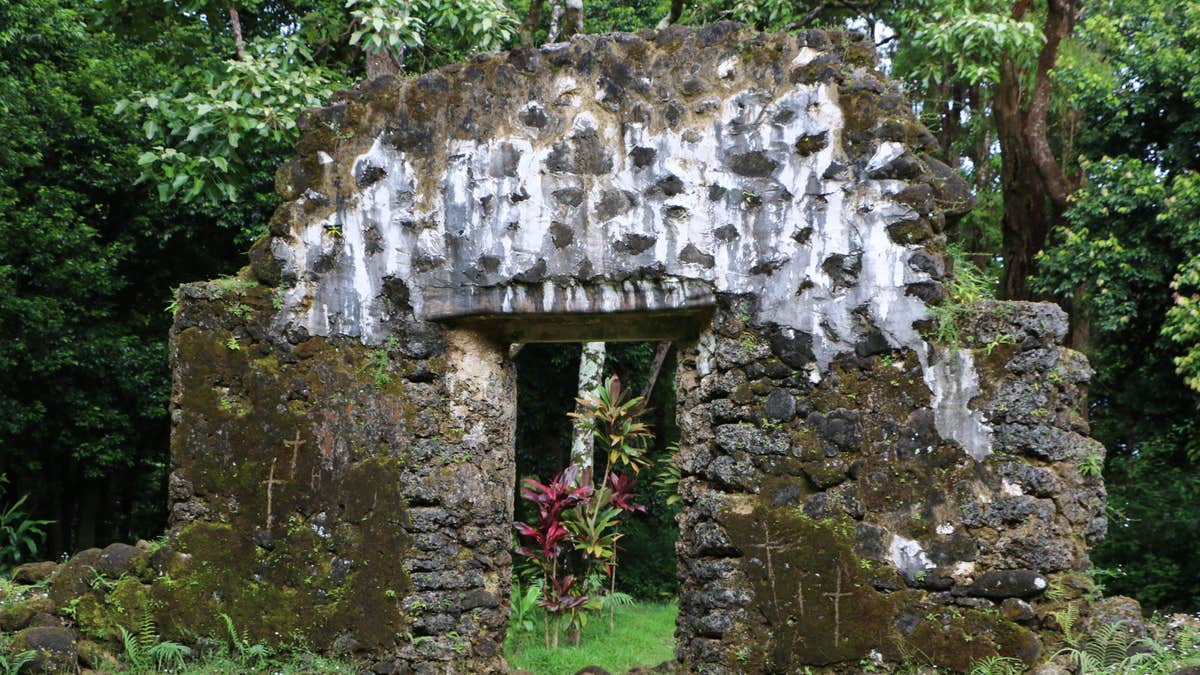
This undated photo, provided by the Hawaii Department of Land and Natural Resources, shows the crumbling remains of the 180-year-old summer palace of former King Kamehameha III where vandals etched crosses in the forest of a Honolulu, Hawaii, neighborhood. (Hawaii Department of Land and Natural Resources via AP)
HONOLULU – Vandals etched crosses on the crumbling remains of the 180-year-old palace of a former Hawaiian king, the Hawaii Department of Land and Natural Resources said Thursday.
But unless the vandals are caught desecrating the sacred cultural site, there's little conservation law enforcement officers can do, the department said.
Kaniakapupu sits in the forest of Nuuanu, a Honolulu neighborhood. It was the summer palace of King Kamehameha III and Queen Kalama and the first government building built in a Western style, with mortar and plaster, according to the state.
Kamehameha III died in 1854 after a 30-year reign, making him the longest-ruling Hawaiian monarch.
The site was also used as a heiau, or place of worship, said Dr. Baron Ching, a Honolulu physician who is vice chair of Ahahui Malama o Kaniakapupu, a group of volunteers who preserve and restore the site.
His group found at least six crosses scratched into three walls earlier this month. Last week, they found various etchings of initials, he said.
It's not the first time the site has been vandalized, Ching said.
"They're carving happy faces, all kinds of stupid stuff," he said. "When you vandalize it or damage it in anyway, there's no way we can repair that."
The site is closed to the public, but that doesn't stop social media sites from luring people there by touting it as a scenic and leisurely hike.
"It's just entertainment for them. It's a part of our history. It's part of our traditions. It's part of our legacy," Ching said. "Go with some respect, for goodness sake."
When Ching and a state official recently visited the site, a family preparing for a photo shoot had spread a blanket over the top of a stone structure outside Kaniakapupu's walls.
That's culturally disrespectful, Ching said: "It's entirely inappropriate to be climbing around this place."
It's considered one of Hawaii's most important cultural sites, the state Department of Land and Natural Resources said.
Within the past month, the department also found etched marks on the walls under a newly restored fence surrounding downtown Honolulu's Iolani Palace, also an important place in Hawaii's history.
"It's hard to understand how anyone thinks it's OK, or pono, to draw or etch graffiti on any of Hawaii's historical or cultural treasures," said department Chair Suzanne Case, using the Hawaiian word that can mean proper or righteous.
It's the latest example of bad behavior in U.S. natural or historic areas.
In May, actress Vanessa Hudgens paid a $1,000 fine for carving into a rock in the national forest surrounding Sedona, Arizona.
Earlier this month, Casey Nocket, 23, pleaded guilty in a federal court in Fresno, California, to seven misdemeanors for an autumn 2014 painting spree at seven national parks including Yosemite in California and Zion in Utah.
She also admitted to defacing rocks at Crater Lake National Park in Oregon and Rocky Mountain National Park in Colorado.
Nocket used Instagram and Tumblr to document her trip and her graffiti-like work, which led to broad outrage on social media.
She was sentenced to two years' probation and 200 hours of community service.

